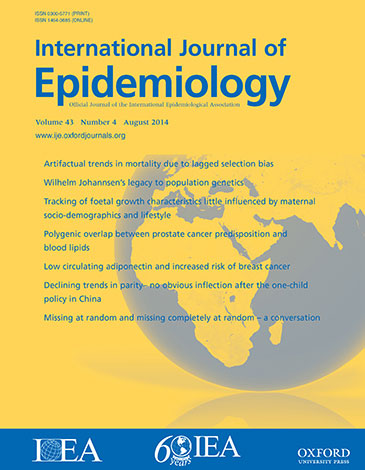瑞士卒中事件、死亡率和病死率的当前趋势:流行病学更新
IF 5.9
2区 医学
Q1 PUBLIC, ENVIRONMENTAL & OCCUPATIONAL HEALTH
引用次数: 0
摘要
脑卒中是一种主要的心血管疾病。瑞士最近一次对脑卒中事件、死亡率和病死率(CF)的流行病学更新是在2004年。2004年至2017年期间,传统和非传统心血管危险因素发生了变化,预期寿命增加,卒中单元实施,卒中治疗标准化。因此,我们提出了最新的瑞士脑卒中流行病学。方法从联邦医院出院统计(HOST, n = 1 470 259)和死亡原因(CoD)数据库(n = 66 971)两个数据库中获取数据,分析2017年瑞士根据I60-I64 (ICD 10)编码的脑卒中诊断。计算了卒中的出院率和事件率、院内和院外CF以及死亡率。结果2017年,瑞士卒中患者出院26032例(45%为女性),而2004年为13996例。女性/男性的年龄标准化事件发生率从2004年的119.7/178.7增加到2017年的265.1/396.7。然而,2004年至2017年间,中风死亡的绝对人数从3569人(60%为女性)下降到2816人(59%为女性)。2004年至2017年,女性(从77.5 /10万降至38.5/10万)和男性(从56.1 /10万降至27.2/10万)的总体性别分层死亡率大约减半。2004年至2017年间,总体CF从22.7%减半至10.5%,女性(13.4%)高于男性(8.0%)。结论:与2004年相比,瑞士卒中事件和出院率有所上升。然而,总CF率和按性别分层的总死亡率大约减少了一半。这表明,除其他因素外,人们对中风的认识有所提高,治疗方法也有所改善。本文章由计算机程序翻译,如有差异,请以英文原文为准。
Current trends in stroke events, mortality, and case fatality in Switzerland: an epidemiologic update
Background Stroke is a major cardiovascular disease. The last epidemiologic update of stroke events, mortality, and case fatalities (CF) in Switzerland was performed in 2004. Between 2004 and 2017, traditional- and non-traditional cardiovascular risk factors changed, life expectancy increased, stroke units were implemented, and stroke treatment standardized. Therefore, we present an update of Swiss stroke epidemiology. Methods Data were obtained from two databases, the Federal Hospital Discharge Statistics (HOST, n = 1 470 259) and the Cause of Death (CoD) database (n = 66 971), to analyze stroke diagnoses coded according to I60-I64 (ICD 10) in 2017 in Switzerland. Discharge- and event rates for stroke, in- and out-of-hospital CF, and mortality were calculated. Results In 2017, there were 26 032 stroke discharges in Switzerland (45% women) compared to 13 996 discharges in 2004. The age-standardized event rate per 100 000 increased in women/men from 119.7/178.7 in 2004 to 265.1/396.7 in 2017. However, the absolute number of stroke deaths decreased between 2004 and 2017 from 3569 (60% women) to 2816 (59% women). The overall sex-stratified mortality rate approximately halved between 2004 and 2017 in women (from 77.5 to 38.5/100 000) and men (from 56.1 to 27.2/100 000). The overall CF halved between 2004 and 2017 from 22.7% to 10.5% and was higher in women (13.4%) compared to men (8.0%). Conclusions Compared to 2004, the rates of stroke events and discharges have increased in Switzerland. However, the overall CF rate and overall sex-stratified mortality rate has approximately halved. This suggests, among other factors, increased recognition and better treatments for stroke.
求助全文
通过发布文献求助,成功后即可免费获取论文全文。
去求助
来源期刊

International journal of epidemiology
医学-公共卫生、环境卫生与职业卫生
CiteScore
13.60
自引率
2.60%
发文量
226
审稿时长
3 months
期刊介绍:
The International Journal of Epidemiology is a vital resource for individuals seeking to stay updated on the latest advancements and emerging trends in the field of epidemiology worldwide.
The journal fosters communication among researchers, educators, and practitioners involved in the study, teaching, and application of epidemiology pertaining to both communicable and non-communicable diseases. It also includes research on health services and medical care.
Furthermore, the journal presents new methodologies in epidemiology and statistics, catering to professionals working in social and preventive medicine. Published six times a year, the International Journal of Epidemiology provides a comprehensive platform for the analysis of data.
Overall, this journal is an indispensable tool for staying informed and connected within the dynamic realm of epidemiology.
 求助内容:
求助内容: 应助结果提醒方式:
应助结果提醒方式:


